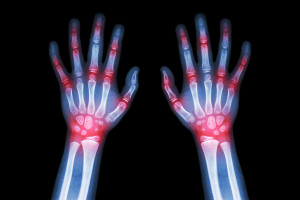 Arthritis develops when cartilage (our inner shock absorber) that normally cushions bone wears away, partially or completely, from years of use, over use or from injury. With no cushioning to protect the joint, it swells and becomes hard to move. Swelling occurs because your body releases fluid to take the place of the cartilage you’ve lost.
Arthritis develops when cartilage (our inner shock absorber) that normally cushions bone wears away, partially or completely, from years of use, over use or from injury. With no cushioning to protect the joint, it swells and becomes hard to move. Swelling occurs because your body releases fluid to take the place of the cartilage you’ve lost.
Arthritis is a tricky diagnosis. There are more than 100 different types of arthritis as well as other related conditions. Signs and symptoms can appear and disappear over and over again.
While joint pain – a dull ache or burning sensation- is the classic symptom and the most easily recognizable, it might not always be the first thing to appear.
Here are a couple of examples:
Early Osteoarthritis symptoms – Soreness and stiffness when joints are not used in a while. Upon waking it takes a bit of time and movement to get going.
What it may feel like:
- Deep joint ache
- Rest helps
- Pain increases as the day goes on
- Pain that radiates into your buttocks, thighs, or groin
- Pain causes limping
- Pain starts with use of the joint
- Swelling in the joint
- Restricted movement of joint
- Feeling or hearing bone grate on bone (clicking/crunching)
- Pain that interferes with daily activities
- Rainy weather is felt in the joints
- Joint stiffness first thing in the morning – diminishes as the day goes on
- Stiffness after rest
Early Psoriatic Arthritis Symptoms – this form is an autoimmune disease. In addition to painfully swollen joints, it can cause eye redness and pain, changes to the nails and skin rashes.
What it may feel like:
Burning
Aching
Throbbing
Stinging
Debilitating at times
Early Rheumatoid Arthritis Symptoms – Usually this effects smaller joints such as toes or fingers and possibly one larger joint. This form of arthritis is symmetrical. If one finger hurts, the one on the opposite hand is soon to follow. Other symptoms that go along with this can be fever, shortness of breath, and even chest pain.
What it may feel like:
- Joint pain that occurs on both sides of the body (mirrored)
- Significant stiffness in the morning
- Aching and weak muscles all over the body
- Overly tired
- Losing weight
- Loss of appetite
- Slight fever
- Swelling of glands
- Joint pain that gets worse after sitting for a long time
- Pain that will ease for periods, then get significantly worse, rather than consistent pain
- Joints may feel hot as well as sore
Gout is also a form of arthritis – Gout is almost exclusive to the big toe joint, though it can also effect the ankle and the knee. This version very much comes and goes. It is exacerbated by eating seafood as well as red meat and drinking beer. Gout can make walking incredibly painful during a flare up.
What it may feel like
- Hot burning sensation in big toe joint
- Painful to the touch
- Pressure hurts
- Shoes are uncomfortable to wear
- Walking is painful
- Relived by ice and splinting
- Relived by proper customized orthotics
Early treatment and prevention are the keys to prolonging health. Arthritis is a progressive disease so the sooner you get help to get it under control the better. Never ignore pain and hope it will go away. Openly discuss all symptoms with your doctor during visits… if it is suspected that you may have arthritis your general practitioner may refer you to a Rheumatologist.
Please visit www.ipalc.org to search for the most qualified Rheumatologists and General Practice physicians in your area.
Share on Facebook




 Southwest Florida Medicine.com is dedicated to bringing you the very best health information available today!
Subscribe or check back regularly!
Southwest Florida Medicine.com is dedicated to bringing you the very best health information available today!
Subscribe or check back regularly!